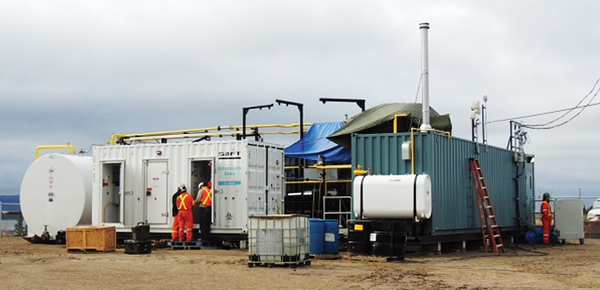Colville Lake, Northwest Territories: Northwest Territories Power Corporation (NTPC) and the Government of the Northwest Territories (GNWT) officially opened the Colville Lake solar/battery/diesel hybrid power plant May 25.
 credit: NWT Power Corporation
The system replaces the first power plant built in 1990, before which the community did not have a source for electricity other than individual generators. The new system includes 136.5 kW of solar PV, 200 kWh of battery storage, three diesel generators (2 x 100 kW, 1 x 150 kW) and a control system that integrates the generation types.
credit: NWT Power Corporation
The system replaces the first power plant built in 1990, before which the community did not have a source for electricity other than individual generators. The new system includes 136.5 kW of solar PV, 200 kWh of battery storage, three diesel generators (2 x 100 kW, 1 x 150 kW) and a control system that integrates the generation types.
“This Government’s investment of $1.15 million has certainly proven successful with today’s opening of the Colville Lake solar/battery/diesel generation plant representing that future we envisioned in the 2013 Energy Action Plan,” said Premier McLeod. “This future is one in which our energy use has less impact on our environment and where we are less reliant on imported diesel fuel.”
The project has been in the works since 2013 when support from the community was attained through community engagement and consultation.
“As Minister responsible for the Northwest Territories Power Corporation, I am very proud of the collaboration that took place to make this initiative successful,” said Minister responsible for the Northwest Territories Power Corporation, Louis Sebert. “It required the cooperation, collaboration and support from local, territorial, federal governments and NTPC – the fact that we are celebrating today is proof that anything is possible when we all work together.”
The new system was designed to replace the plant and generators that had reached end of life. Outages have now decreased in number from more than 30 per year to just two since the system came online in December. The combination of solar/battery/diesel keeps the community’s electrical system more stable than the previous system, reducing outages.
About 80,000 L of diesel fuel will be displaced annually, based on the first quarter of 2016. About 55,000 of those are due to the higher efficiency of the new diesel engines combined with the batteries. Being able to run diesel engines at their optimum rate has improved efficiency by more than 25 per cent.
An additional 24,000 L of diesel is being displaced due to the installed solar farm. The overall efficiency has increased by about 40 per cent.
